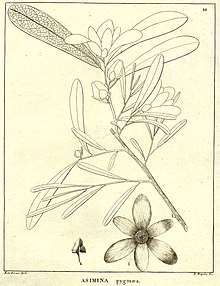Asimina pygmaea
Asimina pygmaea, the dwarf pawpaw, is a species of plant in the family Annonaceae. It is native to Florida and Georgia in the United States.[1] William Bartram, the American naturalist who first formally described the species using the basionym Annona pygmaea, named it after its dwarfed (pygmaeus in Latin) stature.[2][3]
| Asimina pygmaea | |
|---|---|
 | |
| Botanical illustration of Asimina pygmaea | |
| Scientific classification | |
| Kingdom: | Plantae |
| Clade: | Tracheophytes |
| Clade: | Angiosperms |
| Clade: | Magnoliids |
| Order: | Magnoliales |
| Family: | Annonaceae |
| Genus: | Asimina |
| Species: | A. pygmaea |
| Binomial name | |
| Asimina pygmaea | |
| Synonyms | |
|
Annona pygmaea W.Bartram | |
Description
It is a bush reaching 20-30 centimeters in height. It has a spindle-shaped taproot from which one or more branched, or unbranched shoots emerge. Its shoots have red to brown bark with lenticels. Its leathery leaves are 4-11 centimeters long and have rounded or blunt tips, occasionally with a notch. The margins of the leaves are rolled toward their underside. The leaves are dark green and hairless on their upper surface and paler on their underside with a networked pattern of veins. Its twisted petioles are 3-10 millimeters long. Its flowers are on thin, 1.5-4 centimeter long axillary peduncles. Its flowers are a brown-crimson color with a strong yeasty or rotting flesh smell. Its flowers have 6 petals, arranged in two rows of three. Its oblong to oval, fleshy, outer petals are 1.5-3 centimeters long and rolled downward toward their outer surface. Its fleshy, oval inner petals are 0.5-2 centimeters long, deeper in color than the outer petals. The base of the inner petals are swollen, and wrinkled on the inner surface. The tips of the inner petals are rolled back. The stamens are globular, 4-7 millimeters wide and light green to pink at maturity. Its flowers have 2-5 carpels. Its fruit are yellow-green, curved cylinders, 3-4 centimeters in length. The fruit have brown, shiny seeds, each 1 centimeter in length, arranged in two rows.[4][5][6]
Reproductive biology
The pollen of Asimina pygmaea is shed as permanent tetrads.[7] It is pollinated by the dark flower scarab beetle Euphoria sepulcralis.[8] Its flowers produce several scent compounds including dimethyl sulfide which is associated with carrion odor and may attract beetle pollinators.[9]
Habitat and distribution
It has been observed growing in well-drained sandy soils, in pine flatwoods, savannahs and old fields.[9][6]
References
- "Asimina pygmaea (W.Bartram) Dunal". Plants of the World Online. The Trustees of the Royal Botanic Gardens, Kew. n.d. Retrieved January 8, 2019.
- Stearn, William (2004). Botanical Latin. Portland, Ore. Newton Abbot: Timber Press David & Charles. ISBN 9780881926279.
- Bartram, William (1791). Travels through North and South Carolina, Georgia, East and West Florida, the Cherokee Country, etc. Philadelphia: James and Johnson. p. 18.
- Dunal, Michel Félix (1817). Monographie de la Famille des Anonacées (in French and Latin). Paris: chez Treuttel et Würtz. p. 84.
- Brett, M.; Calloway, Dorothy M. (1992). "Our Native Pawpaw: The Next New Commercial Fruit?". Arnoldia. 52 (43): 20–29.
- Kral, Robert (1960). "A Revision of Asimina and Deeringothamnus (Annonaceae)". Brittonia. 12 (4): 233. doi:10.2307/2805119. ISSN 0007-196X.
- Walker, James W. (1971). "Pollen Morphology, Phytogeography, and Phylogeny of the Annonaceae". Contributions from the Gray Herbarium of Harvard University. 202: 1–130. JSTOR 41764703.
- Norman, Eliane M.; Clayton, David (1986). "Reproductive Biology of two Florida Pawpaws: Asimina obovata and A. pygmaea (Annonaceae)". Bulletin of the Torrey Botanical Club. 113 (1): 16. doi:10.2307/2996229. ISSN 0040-9618.
- Goodrich, Katherine R.; Raguso, Robert A. (2009). "The olfactory component of floral display in Asimina and Deeringothamnus (Annonaceae)". New Phytologist. 183 (2): 457–469. doi:10.1111/j.1469-8137.2009.02868.x. ISSN 0028-646X.